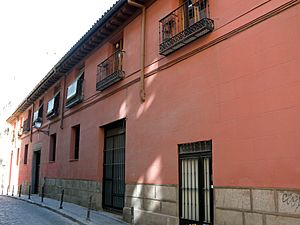Regalía de aposento facts for kids
The Regalía de aposento was a special fee or "royalty" on housing in the old Crown of Castile during the Middle Ages. Think of it as a rule where people had to share their homes with royal officials.
Contents
What Was the Regalía de Aposento?
This old rule meant you had to give up half of your house to royal officials for a short time. In the Middle Ages, the King and his court (important people who worked for him) traveled a lot. So, this fee was only for a short period in a town while the King was visiting.
But things changed when King Philip II made Madrid the permanent capital in 1561. From then on, only people in Madrid had to pay this housing fee.
Unlike the older version, the Madrid housing fee wasn't forced on people. The leaders in Madrid agreed to this "charge" (not really a royalty anymore). They did this because being the capital brought many benefits to the city. A group called the Junta de Aposentadores, first started by King Alfonso XI in 1341, managed this system. From 1621, it was simply called the Junta de Aposento.
Different Kinds of Houses
Over time, houses in Madrid were treated differently regarding this charge. This was because of how complicated the royal money system became. Houses fell into three main groups:
- Houses that had to pay: Owners of these houses had to give up half of their home's space.
- Houses that were excused: Some houses were supposed to pay but didn't. This happened if they were too small or oddly shaped to be split in half. These were often called casas a la malicia (meaning "malicious houses"). Owners of these houses usually paid a money fee instead. This fee was about one-third to half of what the house could rent for. If owners couldn't pay, their houses might be taken over by the Junta.
- Privileged houses: These houses were completely free from the rule. Their owners didn't have to host royal officials. This exemption could be bought or given as a gift by the King.
How the Rule Was Enforced
It was hard for the King's officials to know which houses should pay the fee. Madrid grew very quickly, from 2,500 homes in 1561 to 10,000 by 1618! Also, builders of casas a la malicia were very clever. They built houses in tricky ways, using small spaces like gardens and courtyards. This made it difficult to keep track of everything.
To make the tax fairer, officials started visiting houses. They looked for any unusual situations. As a result of these visits, numbered tiles were placed on many house fronts in old Madrid. You can still see some of them today!
This big effort helped create detailed maps of Madrid between 1749 and 1759. These maps showed the need for better control over the city's population. However, controlling everything was still tough, as shown by problems that arose in 1766, known as the Esquilache Riots.
See also
 In Spanish: Regalía de aposento para niños
In Spanish: Regalía de aposento para niños


